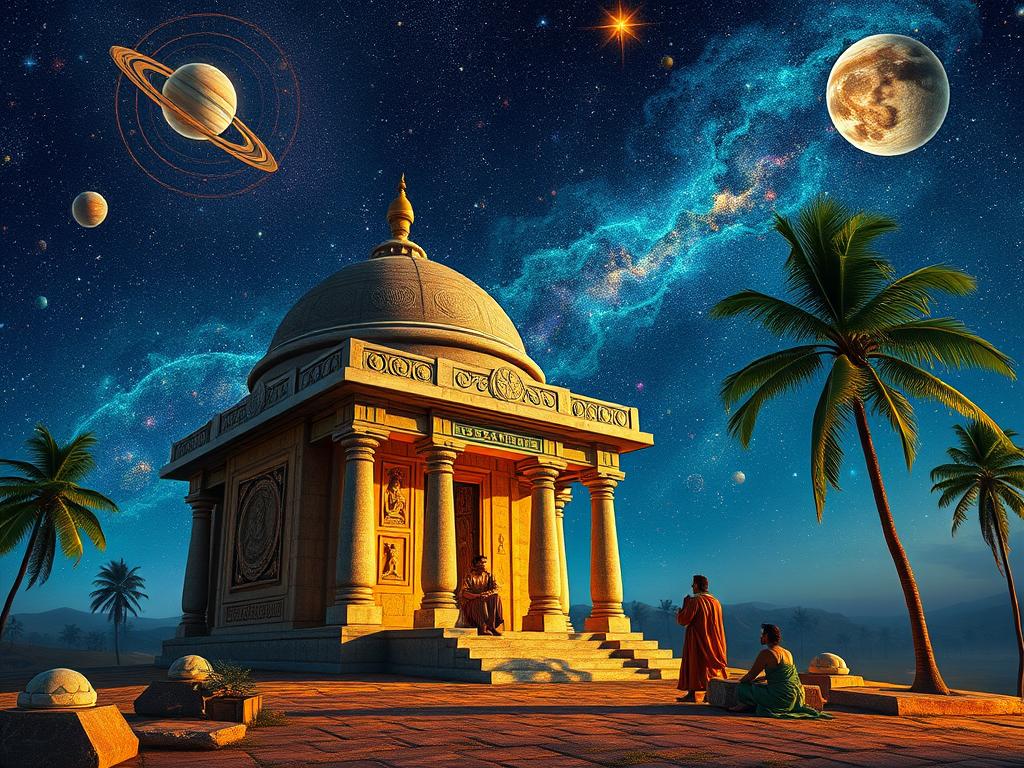Ancient Indian Astronomy: Contributions of Aryabhata, Varahamihira, and Vedic Astronomy
Did you know Aryabhata, an ancient Indian scholar, estimated the Earth’s circumference to be 39,968 km? This was very close to today’s figure of 40,072 km. This shows the advanced knowledge of Ancient Indian Astronomy during the Gupta period, known as India’s Golden Age.
We will look at the key contributions of Aryabhata, Varahamihira, and Vedic Astrology. These contributions greatly influenced our understanding of the universe. They developed the decimal system, including zero, and made accurate predictions of planetary movements and eclipses. Their work still inspires scientists today.

Let’s dive into the fascinating history of Ancient Indian Astronomy. We’ll see its cultural and scientific importance. We’ll also explore the lasting impact of these brilliant minds who expanded our knowledge centuries ago.
The Golden Age of Indian Astronomical Sciences
The Gupta period, from 320 to 550 CE, was a golden time for Indian astronomy. It was a period of great scientific progress. Scholars made big strides in math and astronomy.
The Rise of Scientific Thought in Ancient India
During this era, Indian scholars greatly improved our understanding of the sky. Aryabhata, a famous mathematician and astronomer, introduced the concept of zero and the decimal system. These ideas helped in making more complex astronomical calculations.
Cultural and Scientific Achievements of the Gupta Period
The Gupta period was not just about science. It was also a time of cultural growth. This era saw the rise of classical Sanskrit literature. This literature showed the deep connection between astronomy and ancient Indian life.
Mathematical Foundations of Early Astronomy
The math innovations of the Gupta period were key for astronomy’s growth. Scholars worked hard to understand Planetary Positions, Eclipses, and Astronomical Calculations. Their work led to more accurate and predictive models of the sky.
| Key Contributions | Achievements |
|---|---|
| Aryabhata’s Astronomical Work | Influenced by ancient Indian understanding of mathematics and astrology |
| Varahamihira’s Contributions | Significant advancements in understanding planetary motion and solar system calculations |
| Vedic Astronomy | Emphasized celestial observations and alignments to guide religious practices and rituals |
The Golden Age of Indian Astronomical Sciences set the stage for future achievements. It made India a leader in astronomy and math for centuries to come.
Aryabhata’s Revolutionary Astronomical Theories
Aryabhata was a key figure in ancient Indian astronomy. He was an astronomer and mathematician who made big contributions. His work changed how people understood the sky in the Indian subcontinent.
Aryabhata’s main work, the Aryabhatiya, covered many subjects like math and astronomy. He proposed a heliocentric model, saying the Earth rotates and orbits the Sun. This idea was way ahead of its time, challenging the common view that the Earth was at the center.
Aryabhata was also great at math. He figured out the Earth’s circumference with amazing accuracy. He also found ways to track the planets’ positions, using the sidereal zodiac.
His ideas on Earth’s movement were groundbreaking. They changed the Vedanga tradition, a branch of ancient Indian astronomy and astrology. His work helped start a more scientific way to study the universe, inspiring future astronomers.
Aryabhata’s theories still excite scholars and fans today. They show the deep wisdom of ancient India’s thinkers.
 Biodiversity Hotspots of India: The Unique Species of the Western Ghats and the Himalayas
Biodiversity Hotspots of India: The Unique Species of the Western Ghats and the Himalayas
Ancient Indian Astronomy: Core Principles and Practices
Ancient Indian astronomy was a remarkable scientific effort. It used advanced principles and practices. At its core were Nakshatras (lunar mansions) and Jyotisha (Vedic astrology). These concepts were key to understanding the sky and its effects on us.
Understanding the Vedic Calendar System
The Vedic calendar was based on the moon and sun’s movements. Astronomers and mathematicians tracked the moon’s phases and the sun’s position. This helped plan religious rituals, farming, and special days.
Celestial Navigation Methods
Ancient Indian astronomers developed advanced navigation methods. The Nakshatras system helped track the moon and planets. It guided travelers and set the timing for festivals and astrological events.
Mathematical Models of Planetary Motion
Ancient Indians created accurate models for planet motion. Aryabhata, a famous astronomer, developed the Pancanga system. These models were used for both practical and astrological studies.
The ancient Indians’ deep understanding of the sky still inspires us today. Their work shapes our view of the universe and our world’s rhythms.
Varahamihira’s Contributions to Astronomical Studies
During the Gupta period, Varahamihira was a key figure in Vedic Astrology and Astronomical Calculations. He combined knowledge from many sources, including Greek and Persian texts. His main work, the Brihat Samhita, covered astronomy, astrology, and natural sciences.
Varahamihira’s Brihat Samhita showed his wide range of knowledge. He talked about astronomy, weather, gems, and architecture. His work showed how ancient Indian scholars looked at the world from many angles.
He also made big contributions to Vedic Astrology. Varahamihira studied how stars and planets affect us. His work on planets, eclipses, and cycles showed India’s advanced astronomy skills back then.
Today, Varahamihira is still remembered as a great astronomer and scholar. His work in astronomy and astrology has greatly influenced Indian science. His approach to understanding the world is still studied and admired.
| Astronomer | Key Contributions |
|---|---|
| Aryabhata | Developed accurate methods for predicting eclipses, proposed a heliocentric model, and introduced concepts like zero and gravity. |
| Varahamihira | Compiled and synthesized knowledge from various astronomical texts, including Greek and Persian sources, and authored the Brihat Samhita. |
| Bhaskaracharya II | Calculated the circumference of the Earth and the time of the Earth’s rotation. |
| Srinivasa Ramanujan | Discovered hundreds of new mathematical identities and theorems, contributing to the field of astronomy. |
The Integration of Mathematics and Astronomy
In ancient India, astronomy and mathematics went hand in hand. Famous astronomers like Aryabhata and Varahamihira combined these fields. They greatly expanded our scientific knowledge.
Development of Trigonometric Functions
Aryabhata and others created the sine table. This was a major step forward. It helped them calculate where planets and stars were more accurately.
This work changed astronomy. It made predicting celestial events much better.
Calculating Planetary Positions
Ancient Indian astronomers got better at finding where planets were. They used math and careful observations. This made their predictions more accurate than anyone else’s.
Eclipse Prediction Methods
They also figured out how to predict eclipses and other events. Their knowledge of the sky was unmatched. This showed how smart ancient India’s astronomers were.
 Ayurveda and Medicinal Plants: Exploring Traditional Indian Medicine and Modern Scientific Research
Ayurveda and Medicinal Plants: Exploring Traditional Indian Medicine and Modern Scientific Research
The mix of math and astronomy in ancient India led to big discoveries. They worked on trigonometry, planet positions, and predicting eclipses. Their work still inspires scientists today.
Vedic Astronomy and Religious Observances
Vedic astrology, or Jyotisha, is deeply rooted in Indian culture for centuries. At its core is the Nakshatras system, with 27 lunar mansions. These mansions are key in setting auspicious times for religious events and rituals.
The Vedic calendar, based on astronomy, guides the timing of big Hindu festivals. The Nakshatras and other celestial events help find the best days for things like weddings and starting new projects.
| Vedic Event | Nakshatras Involved | Significance |
|---|---|---|
| Chhath Puja | Shashti Tithi | Celebrated in North India, especially in Bihar and Uttar Pradesh, Chhath Puja is on the Shashti (sixth) day of Kartik. It’s about purity, discipline, and devotion. The Shashti Tithi starts the fast and ends with an offering to the Sun. |
| Diwali | Amavasya (New Moon) | Diwali, celebrated all over India, happens on the Amavasya (New Moon) of Kartik. It’s believed to bring luck and wealth to homes. |
| Ugadi | Chaitra Shuddha Padyami | Ugadi, the New Year in some parts of India, is on Chaitra Shuddha Padyami. It’s the start of a new cycle and a good time for new starts. |
The link between Vedic astronomy and Indian religious events shows the ancient wisdom of India. Vedic astrologers have kept a rich tradition alive. This tradition influences the spiritual and daily lives of millions.
Early Indian Astronomical Instruments and Methods
Ancient Indian astronomers were true pioneers. They created advanced tools and methods for studying the sky. These innovations were key to their work, forming the Vedanga. This branch of Vedic knowledge focused on astronomy.
Traditional Tools for Celestial Observation
Indian astronomers made many tools to explore the heavens. They used the gnomon, a vertical rod to track the sun and measure time. The armillary sphere helped them observe planets and stars.
The chakra-yantra was a circular device with scales. It helped measure the positions of stars and planets.
Methods of Time Measurement
Accurate time was crucial in ancient India. Astronomers used water clocks, sundials, and shadow-casting devices. The Kundika and Kapala were common time-keeping tools.
Astronomical Calculations and Tables
Indian astronomers made detailed tables and methods for their calculations. The Siddhantas were a series of texts with information on planets and eclipses. These helped them make accurate predictions and understand the sky better.
The work of ancient Indian astronomers was groundbreaking. Their tools, time-keeping methods, and calculations were foundational. They created the Vedanga, a lasting legacy in astronomy and Vedic knowledge.
The Legacy of Ancient Indian Astronomical Knowledge
Ancient India’s astronomical knowledge has made a lasting impact on the world. Many ideas and methods from that time still shape our understanding today. The Vedic Astrology uses the sidereal zodiac system, showing how valuable this knowledge remains.
Aryabhata and Varahamihira were key figures in ancient Indian astronomy. They introduced new ways to understand the sky. Their work in math, navigation, and tools helped us predict the stars more accurately.
- The Vedic calendar system is still used today. It helps us keep in touch with the natural world.
- Trigonometry and figuring out where planets are have changed astronomy. They help us predict the sky better.
- Old methods for predicting eclipses are still used. They help us understand these amazing events.
India’s ancient astronomy has touched the world. It has influenced how we see the universe and our place in it. This legacy inspires and guides us today, keeping the work of ancient minds alive for future generations.
Global Impact of Indian Astronomical Discoveries
The achievements of ancient Indian astronomers have changed the world. They introduced the use of zero and the decimal system. These ideas changed math worldwide. They also helped science, including Ancient Indian Astronomy and Astronomical Calculations.
 “I’m Alive” by Céline Dion: The Technology That Keeps Music Timeless
“I’m Alive” by Céline Dion: The Technology That Keeps Music Timeless
Indian astronomers’ work amazed scholars from all over. Their knowledge spread, enriching astronomy in many cultures. It led to new discoveries and a better understanding of the universe.
Today, scientists still learn from ancient Indian discoveries. Their work shows the power of human knowledge. It shows how Indian astronomy has shaped our view of the universe.






